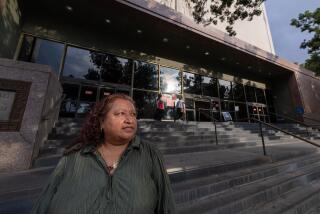Breaking Up Need Not Be Hard to Do
- Share via
Divorce.
It can be the emotional equivalent of slamming a wrecking ball through a family, a process so combative and costly that adults and their children often emerge as shell-shocked victims of a domestic war.
But a group of Ventura County lawyers say it doesn’t have to be that way and is now promoting a new method for achieving civilized divorce.
They call it collaborative law, a form of mediation in which couples pledge not to go to court and instead work with specialized lawyers to resolve issues that typically pop up in divorce cases. Proponents say their approach will be faster, cheaper and less divisive for families.
“It is for people who realize that the best interests of their children are served if there is no animosity,” said Ed Buckle, a Ventura attorney who has handled divorce cases for 20 years.
Buckle is one of 18 lawyers working under the banner of the Ventura County Collaborative Family Law Group, a nonprofit organization that opened for business Sept. 1.
The group, whose members are still charging by the hour, has ruffled the feathers of some local divorce lawyers who believe it is trying to hoard clients at the detriment of other attorneys and established mediators.
But the collaborative lawyers say they just want to offer an alternative for people seeking a divorce.
“Now we have something different to offer people,” said Oxnard lawyer David Schwartz, speaking to a group of lawyers, judges and court officials during a recent presentation.
Schwartz said the goal of collaborative law is to humanize the legal process by fostering a dignified, comfortable atmosphere in which couples can reach their own settlement terms outside a courtroom.
Unlike traditional mediation, divorcing spouses are represented by lawyers throughout the process and sign a contract pledging not to take the case before a judge. Instead, they try to hash out an agreement during four-way conferences held at law offices.
Advocates say their method causes less anxiety for clients and ensures greater confidentiality because meetings are held in private and the details are not part of a public record.
It is also faster--and, as a result, cheaper--because clients avoid depositions and backlogged court calendars that can drag out a divorce case for a year or more, they say.
Family therapists, appraisers or accountants can be retained as needed. But advocates warn that if settlement negotiations fall apart, the lawyers and experts are prohibited from participating in any subsequent litigation.
Schwartz said the provision was added to foster openness.
“Knowing that your spouse’s lawyer will never appear against you, you can be much more open,” he said.
Collaborative law isn’t for everyone.
Couples who prefer nasty to nice are not well-suited for it, lawyers say, and neither are people who have either been abused or are in relationships where one spouse has significantly more power over the other.
But proponents say their method is a good option for couples who are capable of working toward a resolution and who want to avoid litigation that could be harmful to their children.
“Divorce is one of the very worst experiences that any of us can have in our lives,” said Schwartz, who has been the driving force behind the collaborative group.
“I want to be able to offer my clients something that is better for them,” he said. “And I want to participate in a process that is more creative and more rewarding for everyone.”
Schwartz got hooked on the collaborative concept while attending a family law seminar last fall in Northern California, where nine counties, including Santa Clara, Napa, Shasta and San Mateo, have such groups.
After returning to Ventura County, Schwartz decided to form a group here and solicited attorneys he felt were “well-suited” to the process. They met as a group in January and over the last eight months have spent hundreds of hours undergoing conflict resolution and mediation training.
For now, the group is not allowing outside lawyers into their circle, which has upset some members of the family law bar. Critics say the collaborative “club” excludes younger attorneys and is trying to hoard clients.
“They’re painting themselves as the ‘reasonable attorneys’ of the county, when in reality a lot of attorneys just laugh because they have some of the most contentious son-of-a-guns at the heart of that group,” said one lawyer who asked not to be named.
Superior Court Judge Kevin McGee touched on the issue during Schwartz’s presentation last week, asking: “Are you a secret society?”
Schwartz explained that the group kept its numbers small to keep things from becoming unwieldy. Lawyer Donna Santo added that the group plans to add lawyers in the future.
“We just haven’t taken that step yet,” she said.
Currently, the group has no bilingual lawyers--another issue its members say they plan to address.
While the kinks are still being worked out, Ventura County Superior Court judges and staff have embraced the collaborative concept as one more option available to the public.
Court Executive Officer Sheila Gonzalez offered to let the group place its brochures in the courthouse’s self-help clinics, and Supervising Family Court Judge John R. Smiley praised the group’s efforts.
“I think they are trying to offer those people who are going through the difficult process of a divorce an alternative to having their case litigated in a courtroom,” Smiley said a few days after the meeting.
“As far as the court is concerned, any time anybody comes in here with an alternative, or a variety of alternatives . . . the court is always going to endorse that,” he said.
Ventura resident Stephen Kostezak wishes more alternatives had been available to him when he was entangled in a bitter divorce a few months ago.
Kostezak and his wife of 18 years tried mediation and settlement agreements with their attorneys. But it didn’t work, he said. They eventually went to trial.
“It is really painful,” said Kostezak, a 48-year-old employee at a high-tech computer optics firm. “You still have feelings for the person, but it is also adversarial. It is not an easy thing.”
Kostezak isn’t sure the collaborative method would have been effective in his case. But he would have liked to have the chance to try.
“As many options you have,” he said, “the better off you are.”
More to Read
Sign up for Essential California
The most important California stories and recommendations in your inbox every morning.
You may occasionally receive promotional content from the Los Angeles Times.













